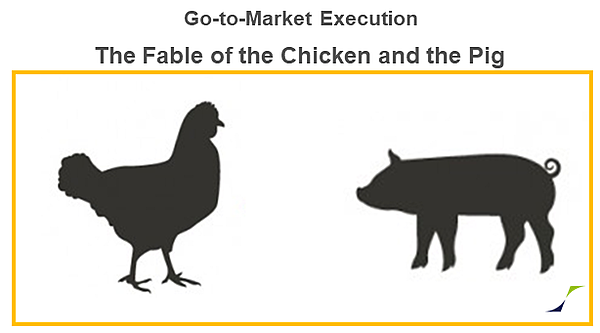When I talk to our clients about how they execute on their Go-to-Market strategy, I usually get a blank look. Other times the reaction is emotional, and I won’t repeat some of the words I have heard to describe it.
The challenge for these companies reminds me of the business fable of “The Chicken and the Pig”. For those who are not familiar with the story, the point of the fable is commitment to a project or cause. When producing a dish made of bacon and eggs, the pig is completely committed.
When it comes to Go-to-Market, for many of these companies, there are too many chickens!
If you are a stakeholder in your company’s technology, product, market, channel or sales function; if you have a big annual quota you should keep reading….
A Few Observations¹
Your company will spend 2X your development budget to market and sell your technology product or solution.
The level of effort to position, message, and package your new product, doesn’t look like a significant undertaking, but when the team gets it wrong the impact on the funnel is huge.
Sales professionals avoid selling a new product or solution when the value to the customer is not obvious.
The marketing team gets plugged into new feature and new product initiatives once development is completed and there is a need to sort out the value proposition.
Who Should Own Go-to-market?
There is a strong case for marketing. One CMO explained to me; “if it has the word market in there it should belong to marketing…” Conceptually, I agree with the logic, but how easy is it in practice?
The responsibilities of marketing have a lot of overlap with go-to-market practices. However, GTM is complicated and all encompassing.
The role of marketing has evolved. It readily includes content marketing, marketing operations in addition to demand generation. Even with the addition of the product marketing role, marketing’s main job is to increase MQL and to enable sales by honing messaging, creating sales tools and collateral.
Except in the largest companies most marketing organizations simply don’t have the skills or resources to marshal all the diverse activities that are required to sustain a Go-to-Market practice.

Another point of view is that Product Management should be accountable for the Go-to-Market success of their products. In theory this makes sense; however, the charter of the product management role is very broad and in most technology companies product managers are focused on well let’s face it—technology! Even a Product Manager, that possesses high business acumen, would not succeed managing the go-to-market for their product in its entirety.
This leaves us where we started; the chickens and pigs dilemma.
The complexity of Go-to-Market means that shared responsibility and accountability is inevitable. Successful Go-To-Market strategy consist of several elements. Each of these areas require unique accountability, roles and responsibilities.
- Value Proposition/Messaging
- Pricing Strategy
- Sales Enablement
- Channel Programs
- Product Launch
Go-to-Market execution is a combination of the disciplines outlined above; success isn’t guaranteed by proclaiming a “one neck to squeeze” approach.
These areas have the potential to become areas of excellence for the company if there is clarity about accountability and responsibility for each of them.
How does a company transition from a casual or ad-hoc method to excellent execution and meaningful results?
The GTM strategy must balance a number of competing disciplines and the sheer breadth and scope of it requires that the execution be shared between at least two functions with diverse goals and time horizons.
Here are a few basic steps:
- Accountability at the senior level including C-suite, product, marketing and sales executives
- Embrace shared accountability and responsibility
- Align Go-to-Market strategy with company’s overall strategic objectives
- Integrate the GTM execution into elements of the annual budget and resource plan
- Define OKRs for all those accountable and responsible
- Over communicate annual GTM objectives themes and timelines
You must be very objective about where you are with the critical elements of your Go-to-Market discipline.
At Egress Solutions Inc., we specialize in helping technology companies assess their Go-to-Market practice. We bring decades of market experience and data driven techniques to identify gaps in your GTM approach. To learn more about our product consulting practice click here.
¹ This information has been gained from recent interviews with Egress clients, marketing and product executives from our community.


